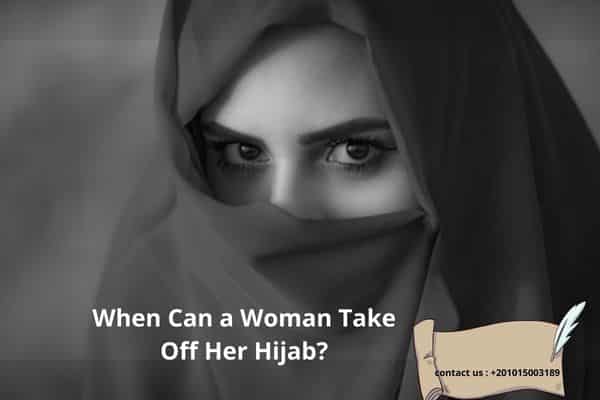When Can a Woman Take Off Her Hijab? The hijab, a headscarf worn by Muslim women, symbolizes modesty and religious commitment. It typically covers the head, neck, and chest, leaving the face uncovered. The decision to wear or remove the hijab varies, being mandatory in some countries while considered a personal choice in others. This article explores the contexts and circumstances in which a woman can take off her hijab.
What is Hijab?
The word “hijab” comes from the Arabic word for “curtain” or “partition.” In the Quran, the hijab is referred to as a way for Muslim women to dress modestly and protect their chastity. The Quran also states that women should not display their beauty to non-mahram men (men they are not allowed to marry).
let’s go and see When Can a Woman Take Off Her Hijab
When Can a Woman Take Off Her Hijab?
There are situations where a Muslim woman may choose to remove her hijab. These exceptions acknowledge the importance of comfort, privacy, and familial bonds:
- In the Privacy of Home: Muslim women can relax and forego their hijab when at home, engaging in daily activities, or spending time alone. Their homes are a sanctuary for comfort and privacy.
- With Mahram: A strong sense of security and familial connection allows a woman to remove her hijab in the presence of her mahram. These are close male relatives she cannot marry, such as her father, brother, husband, or son.
- Among Women: A feeling of sisterhood and ease can be fostered when a Muslim woman removes her hijab around other women, as long as no unrelated men are present.
- Before Puberty: Young girls are not obligated to wear hijab until they reach puberty. After that point, wearing a hijab becomes a personal choice, sometimes reflecting family traditions.
- For Medical Reasons: During essential medical examinations involving the head or scalp, a Muslim woman can temporarily remove her hijab to facilitate the procedure.
Additional Considerations
- During Prayer: Regardless of whether they are actively praying, Muslim women typically cover their hair. They can remove their hijab after finishing their prayers.
- Family Gatherings: In intimate family settings, a Muslim woman may choose to remove her hijab, prioritizing familial bonds over strict adherence to modesty during these special moments.
You must have a guide and a guide to be on the right path. I presented to you when and where you can wear the hijab, but there are some things that you will read in the article. If you want to take the right path and have a comprehensive understanding of the Islamic faith, you can browse our COURSES on Earth and begin your journey in a strong, direct, and correct way.
Benefits of Hijab
There are many benefits to wearing a hijab. Some of the most common benefits include:
- Promotes modesty: Hijab helps Muslim women to dress modestly and avoid attracting unwanted attention.
- Strengthens faith: Wearing hijab can be a way for Muslim women to express their faith and commitment to Islam.
- Sense of community: Hijab can help Muslim women to feel a sense of community and belonging.
- Empowerment: Some Muslim women feel empowered by wearing hijab, as it is a way for them to take control of their own bodies and identities.
What is the purpose of the hijab?
The hijab is a symbol of modesty and religious devotion for Muslim women. It is a way for them to express their faith and commitment to Islam. The hijab can also help Muslim women to avoid attracting unwanted attention and to feel a sense of community and belonging.
What is a hijab vs. burqa?
The hijab and burqa are both headscarves worn by Muslim women, but they are not the same thing. The hijab typically covers the head, neck, and chest, leaving the face uncovered. The burqa, on the other hand, covers the entire body from head to toe, with only a small mesh panel over the eyes.
Is wearing a Hijab Mandatory?
The hijab becomes mandatory for Muslim women upon reaching the age of puberty. This ruling applies universally, regardless of a woman’s beauty. Historical accounts mention the beauty of many women among the Muhajirin (early Muslims who migrated to Medina) and the Ansar (residents of Medina who welcomed the migrants). However, there’s no evidence to suggest the hijab ruling was relaxed for them.
Here’s some additional context to consider:
- Quranic Guidance: The Quran (Surah An-Nur 24:31) instructs Muslim women to cover their chests and draw their garments close to them. This verse, along with scholarly interpretations, is the basis for the hijab requirement.
- Age of Onset: The age of puberty is a crucial marker in Islamic tradition, signifying a woman’s transition into adulthood and the associated religious obligations.
- The universality of Rulings: Islamic rulings generally apply equally to all Muslims, regardless of their beauty or social standing.
Remember:
The purpose of hijab goes beyond simply concealing beauty. It’s a symbol of modesty, faith, and respect for Islamic teachings.
Why Do Women Wear Hijabs?
For many Muslim women, the hijab is a voluntary act of faith and obedience to God’s commandments. It serves as a tangible expression of their commitment to Islamic principles and a way to uphold modesty and privacy. The hijab can also foster a sense of identity and belonging within the Muslim community.
Why Do Some Women Cover Their Faces?
In some cultures, certain Muslim women may choose to cover their faces, often with a niqab or burqa, in addition to the hijab. This practice is often rooted in cultural traditions and personal interpretations of modesty. However, it’s important to note that face veiling is not mandatory in Islam, and there is no consensus among Islamic scholars on its necessity.
Do Women Feel Empowered in a Hijab?
For many Muslim women, the hijab represents empowerment and personal choice. It allows them to express their faith and identity in a way that feels authentic and meaningful. They may find that wearing the hijab enhances their feelings of self-respect, dignity, and connection to their faith.
Why don’t some Muslim women wear the hijab?
The reasons for not wearing the hijab are as diverse as the women themselves. Some women may feel that this is not a religious obligation or that it goes against their personal beliefs or values. Others may face societal pressure or discrimination if they choose to wear them. It is important to respect the individual choices of Muslim women, regardless of their decision regarding the hijab. But there is no doubt that the hijab is obligatory for every Muslim woman, and no woman has the right to leave her home without a hijab, revealing her hair, at work, in the street, or among relatives. This is obligatory in the Islamic faith.
Advice for Women on How to Wear the Hijab
For women who choose to wear the hijab, there are various styles and ways to drape it, allowing for personal expression and comfort. Here are some general tips:
1-Choose the right fabric: Select a breathable and comfortable fabric that suits the climate and your personal preferences.
2-Secure the hijab: Use under-scarves or pins to ensure the hijab stays in place and doesn’t feel constricting.
3-Experiment with styles: Explore different draping techniques and find a style that complements your face shape and personal taste.
4-Accessorize modestly: Add subtle accessories, like headbands or pins, to enhance your hijab style without compromising modesty.
5-Maintain hygiene: Regularly wash your hijab to keep it clean and fresh.
Remember, the hijab is a personal journey, and there is no one-size-fits-all approach. Embrace your individuality and find a way to wear the hijab that feels authentic and empowering to you.
Embark on a Journey of Enlightenment: Deepen Your Understanding of Hijab and Islamic Jurisprudence
At Al-Walid Academy, we invite you to embark on an enlightening journey into the intricacies of hijab and Islamic jurisprudence. Our comprehensive program, designed by esteemed scholars, will equip you with the knowledge and insights to navigate these complex topics with confidence.
Enroll in our program today and:
- Unveil the profound significance of hijab in Islamic tradition and its multifaceted role in a Muslim woman’s life.
- Gain a deeper understanding of Islamic jurisprudence, exploring the legal principles and frameworks that govern various aspects of Muslim life.
- Engage with renowned Islamic scholars who will guide you through the intricacies of hijab and Islamic law, fostering a deeper appreciation for their nuances.
- Enroll in our ISLAMIC STUDIES NOW
Conclusion
The hijab is a complex and multifaceted issue. There are many different views on when a Muslim woman can take off her hijab, and the decision to wear it or not is a personal decision. It is important to respect a Muslim woman’s choices and understand the different reasons why she may choose to wear or not wear the hijab. But in the Islamic religion, the hijab is mandatory, for the reasons mentioned in the article, I hope that you find your answer about When Can a Woman Take Off Her Hijab in our article
FAQs:
Q1: What are the different types of hijabs?
A2: There are various styles of hijabs, each with its unique drape and cultural significance. Some common types include:
- Al-Hijab: The most basic form, covering the head, neck, and chest.
- Niqab: Covers the head, neck, and chest, with a small opening for the eyes.
- Burqa: Covers the entire body from head to toe, with a mesh panel over the eyes.
- Khimar: A loose headscarf that drapes over the shoulders.
- Shayla: A long rectangular scarf that can be draped in various styles.
Q2: What are some challenges Muslim women face in wearing a hijab?
A3: Muslim women who choose to wear a hijab may face various challenges, including:
- Discrimination: Prejudice and bias based on their hijab-wearing, affecting employment, education, and social interactions.
- Stereotyping: Misconceptions about their faith, values, and beliefs due to the hijab.
- Safety concerns: Potential harassment or violence due to their visible religious identity.
Q3: How can we support Muslim women who wear a hijab?
A4: Supporting Muslim women who wear a hijab involves:
- Respecting their choices: Recognizing their right to wear the hijab without judgment or discrimination.
- Educating ourselves: Understanding the significance of the hijab and its role in Muslim women’s lives.
- Challenging stereotypes: Combating misconceptions and promoting accurate representation of Muslim women.
- Speaking out against discrimination: Supporting policies and initiatives that protect the rights of Muslim women.
Q4: What advice would you give to Muslim women who are considering wearing a hijab?
A5: For Muslim women considering wearing a hijab:
- Explore your faith: Delve into Islamic teachings and interpretations regarding hijab to understand its significance.
- Seek guidance: Consult with trusted religious scholars or mentors for personal guidance and support.
- Experiment with styles: Try different hijab styles to find one that suits your comfort and personal preferences.
- Start gradually: Begin by wearing the hijab in private and gradually incorporate it into your daily life.
- Build a supportive community: Surround yourself with supportive individuals who respect your choices.




